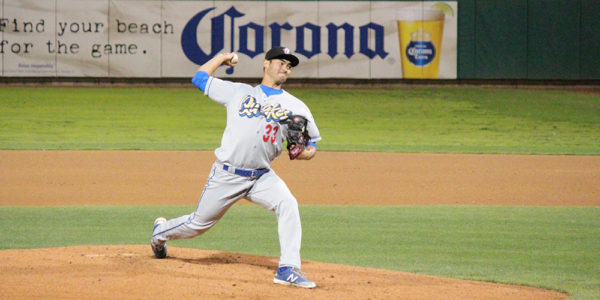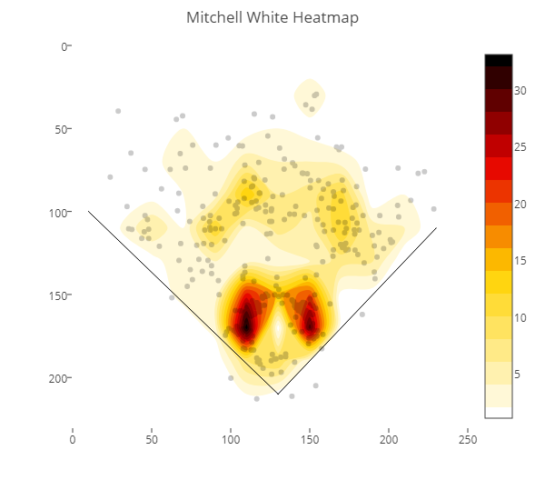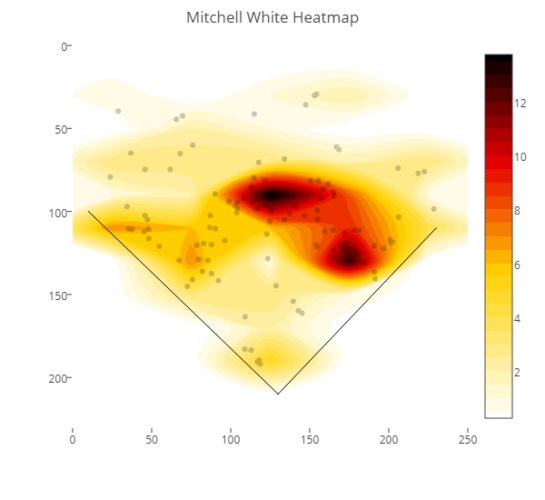
We’re down to No. 8 on the Top 100. This guy might have one of the highest ceilings of anyone in the system, but health and inconsistent stuff has dogged him in his pro career so far.
——
Previously
——
I’ve included Future Value (FV) grades and risks for the Top 50 prospects. For example, if a guy gets a “50 low,” he has a really good chance to be an average player at his position. If a guy gets a “55 high,” there’s a good chance he won’t reach that ceiling, but the potential is there. I tend to give higher future values because I take ceiling into account. The grades are 20-80 (50 is average), and the risks are as follows:
- Low: Players who are usually older, have debuted, are relievers and/or have higher floors than ceilings
- Medium: Players who are a mix of younger and older, usually have higher floors
- High: Players who are usually younger with potential, but also question marks
- Extreme: Players who are younger with star potential, but a ton of question marks
This is to show what value a player might provide at the MLB level. The higher the risk, the less likely a player will reach that ceiling.
——
Editor’s Note: I am not a scout (#notascout). I am an amateur when it comes to evaluating players. I don’t claim to be a pro, I just want to pass along the information I observe/obtain to the people. Notes and comments are based on personal observation, talking to sources, reading scouting reports and watching video. For future entries in this series: All ratings in the charts below are on the standard 20-80 scouting scale, where 50 is roughly average, 80 is elite and nearly unattainable and 20 is unacceptably poor. Enjoy.
Other notes: “Role” is a realistic future role (slightly optimistic in some cases). Age is the 2019 season age for the player (June 30 is the cutoff date).
——
Rating Key
| 80 – Elite |
| 70-75 – Plus-plus |
| 60-65 – Plus |
| 55 – Above-average |
| 50 – Average |
| 45 – Fringe-average |
| 40 – Below-average |
| 30-35 – Poor |
| 20-25 – Very Poor |
——
8. Mitchell White
| DOB: 12/28/94 | Age: 24 | Height: 6’5 | Weight: 229 | Bats: Right | Throws: Right | Position: RHP |
| Tools | Now | Future |
| Fastball | 50 | 60 |
| Curveball | 50 | 60 |
| Slider | 45 | 60 |
| Changeup | 35 | 45 |
| Cmd/Ctrl | 40 | 50 |
| Delivery | 40 | 50 |
| FV/Risk | 55 | High |
| Type of pitcher: Power, gets grounders, inconsistent stuff/performance | ||
Acquired: 2nd round (No. 65 overall) of 2016 MLB Draft, Santa Clara University, $590,800 signing bonus
Physical description: Broad shoulders, ideal SP frame, strong lower half
Strengths: Movement on fastball, different slider/cutter variations, premium stuff
Weaknesses: Injuries, durability concerns, yet to complete a full season
Key statistics: 4.53 ERA, 4.34 FIP, 19.1 K%, 7.4 BB%, 1.03 HR/9
Summary: Before last season, I contemplated putting White at No. 2 in the Top 100. I settled on No. 4 and, well, he didn’t have the best of seasons. He got a late start due to a sore arm and back. When he finally got on the mound, he wasn’t the same guy as the season before. That’s reflected in his high ERA and diminished strikeout rate. In his first 11 starts, he posted an ugly 6.33 ERA. From that point on, he had a much more White-like ERA of 3.30. His stuff had come back after sitting more in the low-90s in the first half. It also impacted his breaking pitches (not as sharp or effective). He was more in the mid-90s in the second half and his breaking stuff improved.
White has a legitimate 3-pitch mix. His fastball ranges from 92-96 MPH and touches 98. He can sink and cut the pitch. It leads to a fair amount of ground balls. The velocity has been inconsistent in his pro career, as has his performance. When he’s right, though, it’s a legitimate swing-and-miss heater. His best breaking pitch varies depending who you talk to. When I saw him in 2017, his curveball was ahead of his slider/cutter. It was a true low-80s hammer that got a lot of swing-throughs. His slider/cutter is interesting. It’s a mid-to-high-80s pitch that he can manipulate. Sometimes it’s a true slider with tilt and depth, sometimes it’s cutter with more horizontal action. Either way, it’s an offering that basically works like two pitches. He also has a changeup that he’s trying to develop to neutralize lefties, but it’s probably an average pitch at best, but it isn’t there yet. He might be better off scrapping it and focus on making his slider and cutter two separate pitches.
White has a frame that screams rotation workhorse. But he hasn’t been able to stay healthy enough to show that. He has a clean, repeatable delivery, but sometimes his quick arm gets ahead of the rest of his delivery, leading to an inconsistent release point. His nagging injuries have also taken away some of his athleticism, making it harder to be consistent with his delivery.
This seems like a glowing report on White, but he has a lot of things to prove in a make-or-break it season for him. If he stays on the mound and shows that strikeout stuff, he could still be a No. 2/3 starter. If not, he’ll be a back-end starter or, more likely, a reliever. He could be a back-end reliever, but his command/control will dictate that. He could get a refresher in Tulsa before getting to Oklahoma City at some point this summer. There’s an outside chance he debuts in the majors this season, but that might be more realistic next season, as he’ll need to be added to the 40-man roster to be protected from the Rule 5 Draft.
Heatmaps


Videos
2018 Ranking: 4
2019 Location: Double-A Tulsa/Triple-A Oklahoma City
ETA: 2020
Next Up: Prospect No. 7
 Dodgers Digest Los Angeles Dodgers Baseball Blog
Dodgers Digest Los Angeles Dodgers Baseball Blog